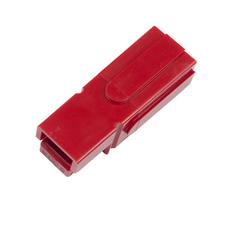I just wanted to add some confusion to this thread because I've been reading a lot about winch motor/Amp draw and the proper electrical protection, if one wants to add it. Maybe I'm over-thinking this stuff, but it's like a fire extinguisher, you may never need it, but a life-saver if you do. Google winch fires if you want to see for yourself.
FWIW, Superwinch includes a 'Circuit Breaker' with their winches that bolts to the Pos (+) battery terminal. It's 3 or 4 50A breakers in series (depending on winch- pic below), bolted to buss bars which one then wraps in electrical tape. Crude at best, but a cheap workable solution. Common on J**ps. I personally want something cleaner.
However, for future readers of this thread, one can buy these assemblies aftermarket (etrailer).
SuperWinch engineers (their website) say protection *should* be about 45% of peak load to avoid motor or solenoid damage/overheat.
So why only 150A or 200A protection for a winch that is rated at 400-500A at full load? Because the winch motor can only draw as much at the system can supply. It might *want* to draw 300 amps, but if the system is a 55amp (or 80A FJ62) plus battery drain, then that's all you're gonna get. And Fuse or CB act on Temp, not really amperage, so according to Superwinch, with a 2-gauge cable 150 amp of circuit breaker is gonna heat up enough to trip the CB at an equivalent of 400 amps. 400 or 500 amps of protection might allow the motor/cable to heat to damage/fire level before the protection kicks in...
So what one is really trying to protect against is a dead-short, in case of an accident or some other potential breakdown of the Pos lead insulation, or a situation where the Winch won't turn off.
I admittedly have very little electrical knowledge beyond my own experience and reading and the usual university physics classes.
But it seems to me, if one were to either 'Fuse' or 'Circuit Break' the system, 500A would be way too high to avoid damage?
I've gone back and forth on whether or not to just use a disconnect or fuse or CB this system. Certainly any choice will work and each has its own advantage/disadvantage.
What do you all think?

FWIW, Superwinch includes a 'Circuit Breaker' with their winches that bolts to the Pos (+) battery terminal. It's 3 or 4 50A breakers in series (depending on winch- pic below), bolted to buss bars which one then wraps in electrical tape. Crude at best, but a cheap workable solution. Common on J**ps. I personally want something cleaner.
However, for future readers of this thread, one can buy these assemblies aftermarket (etrailer).
SuperWinch engineers (their website) say protection *should* be about 45% of peak load to avoid motor or solenoid damage/overheat.
So why only 150A or 200A protection for a winch that is rated at 400-500A at full load? Because the winch motor can only draw as much at the system can supply. It might *want* to draw 300 amps, but if the system is a 55amp (or 80A FJ62) plus battery drain, then that's all you're gonna get. And Fuse or CB act on Temp, not really amperage, so according to Superwinch, with a 2-gauge cable 150 amp of circuit breaker is gonna heat up enough to trip the CB at an equivalent of 400 amps. 400 or 500 amps of protection might allow the motor/cable to heat to damage/fire level before the protection kicks in...
So what one is really trying to protect against is a dead-short, in case of an accident or some other potential breakdown of the Pos lead insulation, or a situation where the Winch won't turn off.
I admittedly have very little electrical knowledge beyond my own experience and reading and the usual university physics classes.
But it seems to me, if one were to either 'Fuse' or 'Circuit Break' the system, 500A would be way too high to avoid damage?
I've gone back and forth on whether or not to just use a disconnect or fuse or CB this system. Certainly any choice will work and each has its own advantage/disadvantage.
What do you all think?

